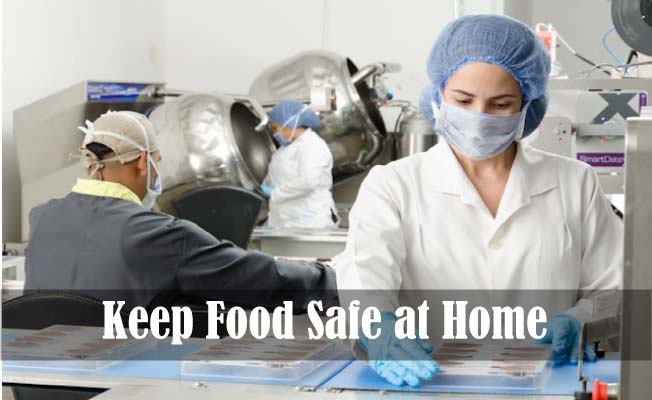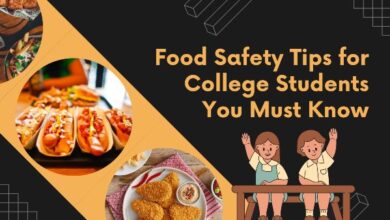5 Ways to Keep Food Safe at Home: Understand and Apply Them

Foodborne illness has been a global concern for the last couple of decades. Every year, millions of people suffer because of unsafe food, which could be prevented by properly handling food and food ingredients at home and in restaurants.
Many of us, whether seasonal cooks or lifelong learners do not know the basic principles of preserving food safely at home.
In this article, I will go through the possible solutions that will help you to handle and store your food at home, and you will know how to keep it safe for a long time.
Why Aren’t Home Cooks Aware of Food Safety and Hygiene?
It’s common to have training on food safety for restaurant professionals as they have to maintain the Food Service Code and Regulations by State. So most of the related persons to restaurant business know the ins and outs details of food safety.
But knowing food safety is not typical for home cooks. And this incident is not entirely unnatural.
However, anyone can practice the primary and essential principles at home and help their family be safe from foodborne illness and financial loss.
Those practices include the following steps:
- Maintaining Maximum Cleanliness and Sanitization
- Cleaning Freezers and Storerooms Regularly
- Avoiding Cross-Contamination by Storing Foods Separately
- Avoiding Food From Danger Zones (40°F to 140°F)
- Cooking at the Required Temperatures
Maintaining Maximum Cleanliness and Sanitization
A dirty, untidy kitchen is a doorway to welcoming bacteria and other microorganisms to spread at the highest rate. On the contrary, cleaning does not mean only rubbing and cleaning with a sponge. Therefore, it’s a combination of several processes.
First, start by washing your hands. I am sure you maintain basic hygiene after using the washroom. But cooking is a process where germs spread mainly through the user’s hands. The WHO recommends people wash their hands for 20 seconds to kill harmful bacteria. And don’t forget to wash between the different tasks during cooking.
Secondly, you have to make sure you are cleaning every item in the kitchen before and after the cooking session. All the utensils, shelves, cabinets, boards, and knives must be washed daily each time they are used. You can use kitchen-grade detergents with warm water. Use hot water to work with high-risk foods like meats and poultry.
Thirdly, you must wash fruits and vegetables before peeling or slicing them. Do not use soap; just gently rub under running water or in a bowl full of water. However, some fruits and vegetables come with the label “no further washing necessary.” If you have those packets, do not rewash them before eating. They are ready to eat without washing.
Cleaning Freezers and Storerooms Regularly
Freezing helps to preserve food products for a long time. But does that mean you can store them for unlimited days? Unfortunately, no. As per the United States Department of Agriculture guidelines, you can store most of the food ingredients for a maximum of 1 to 4 days. For instance, you can refrigerate raw ground meats, poultry, seafood, and a variety of meats (liver, tongue, chitterlings, etc.) for only 1 to 2 days before either cooking or freezing. Besides, you can keep beef, veal, mutton, lamb roasts, steaks, and chops for 3 to 5 days.
For fruits and vegetables, you can store them for two weeks.
We all keep leftover food for later consumption. But those also need to be consumed within 3 to 4 days. After that, leftover food becomes unsafe.
Avoiding Food From Danger Zones (40°F to 140°F)
The ideal refrigerator temperature is 40 degrees Fahrenheit or below. However, most foods must be cooked above 140 degrees Fahrenheit to kill the harmful germs. This is because bacteria grow fast between 40°F and 140°F, which researchers refer to as the danger zone.
Therefore, it’s crucial to maintain the right temperature for storing food. The following steps might help you:
- Try to freeze foods within two hours of buying them from the store. While you are on the drive home, make sure the food items do not get heated much. Apply the same principle to keep cooked foods in the refrigerator within two hours of cooking.
- When you are working with food ingredients, don’t keep them in the cabinet, waiting to be cut or chopped, for very long. Instead, keep them under running water if they need a wash. For frozen ready-to-cook foods, just take them out of the freezer before cooking. And for foods that need to warm up, place them inside the microwave.
- It’s bad practice to keep hot or warm food in the freezer. It increases the risk of salmonella spreading to other foods. It would be best if you waited till the food came down to room temperature. Another problem is that hot foods increase the temperature inside and force other foods to reach over 40°F, a danger zone.
Avoiding Cross-Contamination by Storing Foods Separately
Food becomes contaminated by bacteria in many ways. And the most substantial reason is cross-contamination. The unsafe food passes the harmful germs to other safe foods when they contact each other. And this incident often happens due to storing different food items together.
As a home cook, you might have a few options to keep them separately inside freezers, as domestic refrigerators do not offer bigger spaces like commercial ones. First, however, you might try the following to keep food from contamination:
Avoid Cross-Contamination While Freezing
- The thumb rule is to keep raw meats in a sealed container at the bottom of the freezer. Raw meats like beef, lamb, veal, mutton, fish, and chickens hold numerous harmful bacteria naturally. Make sure not to drip meat juice over other foods.
- Organize your freezer according to food types. Like, you might need some elements that don’t need to be frozen quickly. Keep them on the front side so you can easily take them out for consumption or cooking.
- Commercial eggs are usually safe from dirt and bacteria as the manufacturers wash and then coat them with food-grade edible oil. However, keep them in egg racks or on the inside doors so that if any piece accidentally breaks, they don’t drip over other open foods.
- Keeping foods in plastic containers will increase safety.
Avoid Cross-Contamination While Cutting
- Use a separate cutting and chopping board for raw meat and fish. And another one for other fruits and vegetables. These different uses should be applied to other utensils, knives, cooking pots, etc. as well.
- Wash them with hot water after working with raw meats.
Cooking at the Required Temperatures
Cooking at the right temperature cooks away harmful bacteria. Different food items require different cooking temperatures. You can use a thermometer at home to check and ensure the proper heat. If you are an expert cook, you already know how to manage it.
Follow the below list of temperatures following the USDA:
- Beef, Mutton, Veal & Lamb Steaks, chops, roasts: 145 °F (62.8 °C) and allow to rest for at least 3 minutes
- Ground Meats: 160 °F (71.1 °C)
- Ground Poultry: 165 °F
- All poultry (breasts, whole bird, legs, thighs, wings, ground poultry, giblets, and stuffing): 165 °F (73.9 °C)
- Eggs: 160 °F (71.1 °C)
- Fish & Shellfish: 145 °F (62.8 °C)
- Leftovers: 165 °F (73.9 °C)
- Casseroles: 165 °F (73.9 °C)
It’s also essential to eat food when it’s warm or hot. So serve and eat quickly. If you like to have it later, don’t keep it waiting for over 2 hours.
Final Thoughts
Food safety is not only a day-to-day practice; it’s a responsibility. But unfortunately, while considering whether restaurants prepare food safely, we forget to apply the same safety principles at home.
The five basic rules or methods discussed in this article are good enough to ensure food safety and hygiene at home. You should follow these methods to prepare food safely, ensure good health for your family members, and prevent foodborne illness.



